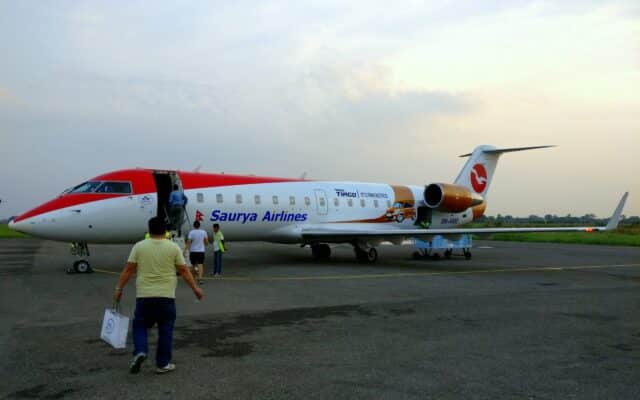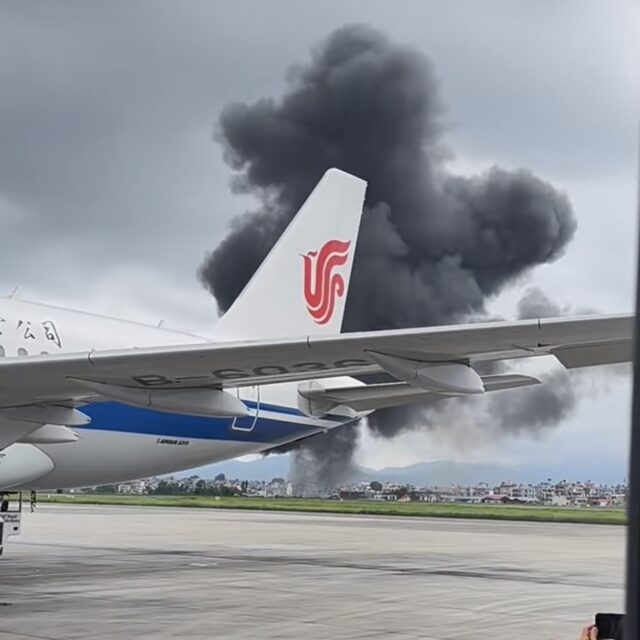Nepal’s Aviation Safety Under Scrutiny After Deadly CRJ200 Crash
On the 24th of July 2024, a devastating crash killed seventeen engineers and the first officer seconds after take-off from Tribhuvan International Airport at Kathmandu.
Saurya is a tiny airline operating a specialized aircraft in one of the world’s most demanding airports. The Nepalese domestic carrier was founded in 2014 with a Bombardier CRJ200 registered in Nepal as 9N-ALE. They officially operated “scheduled charter flights” as they did not have the minimum number of aircraft to operate as a scheduled passenger carrier with only one plane.
In 2017, Saurya Airlines purchased a second CRJ200, 9N-AME, built in 2003 and previously operated by Atlantic Coast Airlines.
Image: 
In 2018, Saurya aircraft were grounded by Tribhuvan International Airport as the airline owed the airport 30 million Nepali rupees in fees, over 200,000 USD in today’s money. The airline, including the two CRJ200s, was sold to “Nepali entities”, then in 2019, the Indian Kuber Group acquired the lot. The debts were cleared and Saurya Airlines restarted operations.
The Bombardier CRJ200 is a regional jet with 50 passengers seats. It’s designed by Canadair and produced by Bombardier Aerospace and popular for short-haul flights. It has a high rate of climb making it particularly suited for the mountainous terrain of Kathmandu.
The second CRJ200 (9N-AME) suffered a bird strike in 2018 while taking off from Kathmandu. The crew heard a sound but were not sure what the cause was and the instruments did not show any issues, so they continued the flight. The dead bird was found on the runway, after their departure. About midway through the flight, the aircraft started vibrating. They landed safely at their destination but found that two of the fan blades of the left engine were damaged. As the initial CRJ200 (9N-ALE) had been withdrawn from service, the airline had to cancel all flights during the repairs.
In 2020, they purchased a third CRJ200, 9N-ANM, which is still operational, bringing their active fleet up to two. As of this accident, Saurya Airlines fleet again consists of only one aircraft.
Tribhuvan International Airport (VNKT), in the foothills of the Himalayas, is known as one of the most challenging airports in the world. It has a single runway running north to south, 02/20.
The CRJ200 was going to Pokhara, where the marketing head of Saurya Airlines told Reuters that the aircraft was scheduled to undergo maintenance for a month beginning the following day. This was for a routine C Check, a heavy maintenance inspection which is conducted every 18 to 24 months.
The one-hour flight from Tribhuvan to Pokhara was clearly for this maintenance and it is acknowledged that it was not meant as a passenger flight. In some local press, it is referred to as a test flight.
That day, the 24th of July, the CRJ200 had two pilots and 17 passengers on board. Initially, it was reported that those on board were all Saurya Airlines technicians but it has since become clear that one technician was travelling with his wife and their four-year-old child.
Shortly after 11:00 local time (06:00 UTC), the flight taxied to runway 02, which has 10,000 feet of asphalt at an elevation of 4,313 feet. Visibility was poor. After the CRJ100 lifted off, it appeared to turn right, according to a ground observer. This was odd because, he said, aircraft was expected to turn left. It’s true that there is standard left turn departure to head east via DARKE and flying at or above 10,500 feet which clears the mountains and would set them up nicely for the flight to Pokhara. However, the aircraft seems to me to have been to low to be starting the turn to follow the departure.
The CRJ200 was clearly in trouble while still over the runway, with a sudden movement to the right before it rolled to the side and fell back to earth. The wing tip struck the ground on the right side of the runway, followed by the full impact. A fire burst out. The aircraft skidded towards the edge of the table top, striking a cargo container at the edge of the airport premises. Part of the cockpit broke off, embedded in the cargo container. The rest of the aircraft was torn to pieces as it fell into a gorge east of the runway.

Within minutes, the captain was pulled out of the cockpit and taken to hospital. Three of the passengers were pulled from the wreckage in the gorge. There were no other survivors. The three rescued passengers died on the way to the hospital.
Various videos have appeared on Twitter, mostly unattributed. If you are reading on the mailing list, you may need to click through to view. These videos depict the actual crash and are disturbing to watch.
This video of the crash appears to have come from airport CCTV.
Truly horrible video and charred plane images coming in.
India should try to help Nepal. So many crashes. And similar horror videos thereafter.@icao @dgcaindia @meaindia @rammnk saurya airlines
— Tarun Shukla (@shukla_tarun) July 24, 2024
This one shows another CCTV view, this time from the east side of the airport
Footage of the Bombardier CRJ 200 crash in Nepal on July 24th, 2024. The pilot was the only survivor of the 19 people on board. pic.twitter.com/tm61wYX4PS
— Planesanity (@planesanity) July 25, 2024
And finally, this one shows the belly of the CRJ200 while coming down, taken by someone on the ground.
WATCH | This video reportedly shows the moment when the Saurya Airlines plane crashed at the TIA Airport in Kathmandu.Nepal pic.twitter.com/HbuN5RQynB
— Republic (@republic) July 24, 2024
Nepal has a long and troubled history within aviation and Nepali airlines have been blacklisted in Europe for over eleven years due to safety concerns. The ICAO audit of Nepal’s air safety in 2022 showed improvement but still listed issues implementing their Aviation Safety Plan. Nepal performed below the global average in three areas, including accident and incident investigations. One reason for this is that they assign commissions for each investigation rather than using trained personnel.
“We admit that the response on the accident and incident investigation indicator is very poor,” said an official at the ministry. “The audit team has pointed out the need for proper training for investigators, and the need for the latest investigation kits.”
Nepal has been investigating incidents and accidents by forming a commission mostly headed by former directors general and secretaries at the Tourism Ministry. The audit has pointed out that investigation requires “trained manpower.”
“But we are making efforts from our side,” said the ministry official. “We have prepared investigation guidelines and have sent them to the Law Ministry for its consent. Once it gives a go-ahead, the guidelines will be tabled at the Cabinet for approval.”
“We have planned to pass the legislation by June,” said the official.
That article was published in April 2022.
In 2024, it seems that nothing has changed. The Nepali government has formed a five-member commission to investigate the crash. The commission is led by the former director general of the Civil Aviation Authority of Nepal (CAAN). The rest of the group consists of a Nepal Airline captain, a Shree Airlines engineer, an assistant professor from Pulchowk Engineering Campus and the technical officer from the Ministry of Culture, Tourism and Civil Aviation. As per ICAO annex 13, the Canadian TSB would normally be invited, as the state of manufacture of the aircraft. The CF34 engines were manufactured in the US which could also open the door for the NTSB to assist. However, at this point, a month after the accident, there’s been no reference to either taking part.
It’s not clear what caused the sudden turn and roll. Families of those killed in the crash are asking why the flight was permitted when it was known to have technical issues. I have not found any reference that the aircraft had known technical issues before the flight. A C Check is routine. A spokesman from Saurya told the press that the CRJ200 had two hundred engine hours left before the full maintenance was required and that they had planned the C Check to start the following day in order to have the aircraft ready, as a key festival was just two months away. No comment has been made on how it happened that the wife and child were included in a ferry flight.
However, an anonymous source, described only as a senior airline executive, stated that the CRJ200 had spent 30 days parked at Tribhuvan, pointing out that Saurya does not have a hangar in Kathmandu.
The local press has reported engine failure, bird strike and maintenance issues to be possible factors.
One airport official said he heard “cracking noises” from the aircraft directly before the crash.
Another theory is that the CRJ200 had been loaded with maintenance kits which shifted, causing the sharp bank and possibly the cracking noises. However, I have not been able to find any confirmation of the aircraft’s cargo.
The flight data recorders have been recovered from the wreckage and handed to the commission. The commission have been given 45 days to complete their report. I can only hope that this is the time frame for a preliminary report and not the full investigation.








I refrained from adding (again) in the title.
On a positive note, the Tribhuvan runway was finally extended in 2020, 5 years after a Turkish airbus thought it was getting extended and failed to find the runway in the fog, as described in “The Database Error And The Turkish Airlines Airbus”.
Not that it helped the Saurya aircraft much.